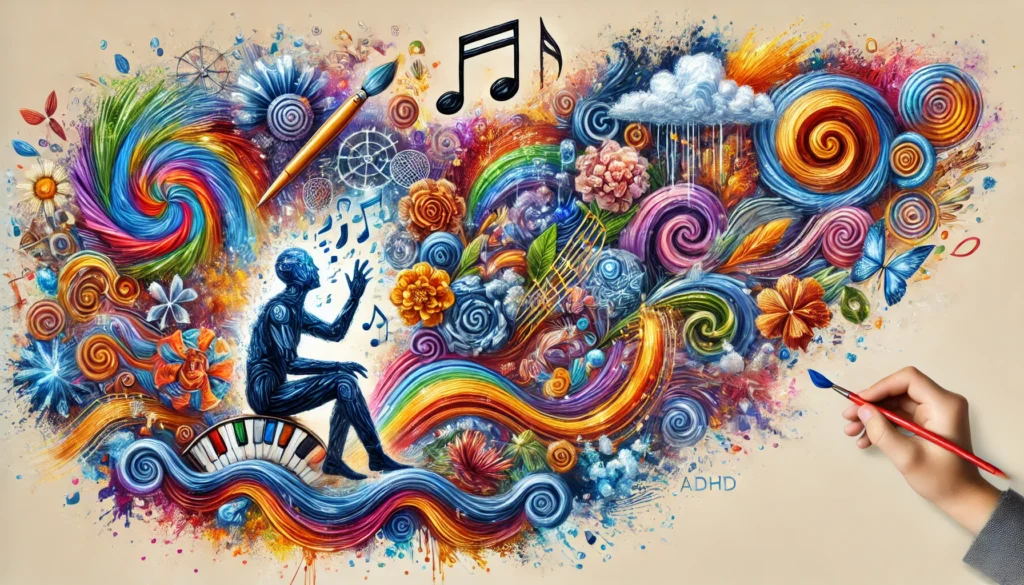
Have you ever found yourself a little… overly aware of what’s happening around you? Maybe the hum of a fan sounds like a jet engine, or a random whiff of coffee is so strong it could practically lift you off the ground. If that sounds familiar, you’re not alone. People with ADHD have a brain that treats sensory stimuli like a box of fireworks on the Fourth of July—all at once, and sometimes a bit more than expected. But this heightened sensitivity can be your secret superpower for creativity. Let’s dive into why that is.
Why Your Brain Picks Up on Every. Single. Thing.
One of the key neural mechanisms driving this sensory sensitivity in ADHD is thought to be related to differences in dopamine regulation. The neurotransmitter dopamine plays a big role in how our brains prioritize information. In ADHD brains, there tends to be a lower baseline of dopamine activity, which can lead the brain to seek out more stimulation and find reward in novel or intense stimuli. This is compounded by differences in the thalamus, a brain structure that usually acts like an air-traffic controller for sensory information, helping filter out unnecessary stimuli. In people with ADHD, the thalamus may be less efficient at this filtering role, which means more sensory information reaches conscious awareness. So, while a neurotypical brain might decide, “We don’t need to focus on the tapping pencil across the room,” an ADHD brain is more likely to think, “Whoa! What’s that sound? Let’s tune in!” This combination of dopamine-seeking behavior and filtering differences creates a heightened, almost magnetic attraction to sensory details in the environment.
Here’s the interesting part: because your brain is so eager to soak up sensory input, it tends to process and integrate all this information in a way that’s different from neurotypical processing. Neurotypical brains tend to sift through the incoming data with a fine-tooth comb, allowing only the essentials through. But with ADHD, your brain is like, “Let’s keep it all—who knows what we might find useful?”
This openness can lead to a unique blend of sensory impressions. When all these stimuli come together in your brain, they start making connections that are anything but obvious. The end result? A fresh, original perspective on the world. You’re seeing what others miss, hearing what others ignore, and piecing it together in ways that can unlock your creative potential.
How Sensory Sensitivity Fosters Creativity
This openness can lead to a unique blend of sensory impressions. When all these stimuli come together in your brain, they start making connections that are anything but obvious. The end result? A fresh, original perspective on the world. You’re seeing what others miss, hearing what others ignore, and piecing it together in ways that can unlock your creative potential.
Your brain’s fascination with all the little details can actually be a huge asset when it comes to creativity. When you’re hyper-aware of everything, your brain is constantly combining different sensory experiences, often in ways that others wouldn’t think of. This is why many people with ADHD have a knack for art, music, writing, and other creative pursuits. Your heightened sensitivity fuels your imagination, letting you see possibilities where others see just… wallpaper.
Your heightened sensory awareness can be challenging, but it can also be the perfect recipe for unique, boundary-pushing creativity.
Ways to Leverage and Develop Your Creative Spark
So, how can you channel all this sensory stimulation into creative gold? Here are some tips to get you started:
- Create a Sensory-Friendly Workspace – First things first: while sensory input is your friend, sensory overload is not. Design a workspace that limits distractions without stifling your senses. Use noise-canceling headphones or ambient music to tune out the extra noises, and consider soft lighting and textures that feel good to you. Once your brain isn’t being bombarded with unnecessary input, it’ll be easier to focus on the creative stuff.
- Use “Inspiration Stashes” – Because you notice so many details, why not use them to your advantage? Keep a notebook or a photo album for ideas, images, and bits of sensory experiences that inspire you. Later, when you need some creative fuel, dip into these stashes and see what connections spark up.
- Embrace Multi-Sensory Creativity – ADHD brains love multi-sensory experiences, so try incorporating more than one sense into your creative pursuits. If you’re writing, listen to music that matches the mood of your piece. If you’re painting or designing, think about textures and colors that stimulate different senses. The more senses you engage, the richer and more dynamic your work can become.
- Channel Overload into Brainstorming – When your brain feels like it’s buzzing from all the sensory input, lean into it! Use that energy to brainstorm without judgment—just throw every idea out there and let the wildest connections happen. Later, you can sift through and pick the gems, but for now, let your brain do its thing.
- Take Creative Breaks – When things start to feel overwhelming, shift your focus to something completely different—a quick walk, a short doodling session, or even a snack break (extra points for snacks with a fun texture). These little pauses help reset your brain and allow all that sensory input to simmer into something creative.
Embracing Your Creative Sensitivity
Living with an ADHD brain that’s attuned to the finer details of the world isn’t always easy, but it can be incredibly rewarding. By embracing your sensitivity to sensory stimuli, you can unlock new layers of creativity that make your work—and your experience of the world—unique. So, the next time you catch yourself noticing something random, know that your ADHD brain is simply gathering inspiration. The world’s a carnival, and you have a front-row seat. Enjoy the show!
References
- https://www.additudemag.com/penn-holderness-adhd-creativity/—
- https://www.addept.org/living-with-adult-add-adhd/adhd-and-creativity—
- https://www.frontiersin.org/journals/psychiatry/articles/10.3389/fpsyt.2022.909202/full—
- https://www.psychologytoday.com/us/blog/mythbusting-adhd/202205/the-link-between-creativity-and-adhd—
- https://www.adhdcentre.co.uk/unlock-your-hidden-talents-using-adhd-to-fuel-creativity/—


